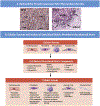Extracellular Matrix in Ischemic Heart Disease, Part 4/4: JACC Focus Seminar
- PMID: 32354387
- PMCID: PMC7269147
- DOI: 10.1016/j.jacc.2020.03.020
Extracellular Matrix in Ischemic Heart Disease, Part 4/4: JACC Focus Seminar
Abstract
Myocardial ischemia and infarction, both in the acute and chronic phases, are associated with cardiomyocyte loss and dramatic changes in the cardiac extracellular matrix (ECM). It has long been appreciated that these changes in the cardiac ECM result in altered mechanical properties of ischemic or infarcted myocardial segments. However, a growing body of evidence now clearly demonstrates that these alterations of the ECM not only affect the structural properties of the ischemic and post-infarct heart, but they also play a crucial and sometimes direct role in mediating a range of biological pathways, including the orchestration of inflammatory and reparative processes, as well as the pathogenesis of adverse remodeling. This final part of a 4-part JACC Focus Seminar reviews the evidence on the role of the ECM in relation to the ischemic and infarcted heart, as well as its contribution to cardiac dysfunction and adverse clinical outcomes.
Keywords: biomarker; collagen; fibroblast; heart failure; ischemic heart disease.
Copyright © 2020 American College of Cardiology Foundation. Published by Elsevier Inc. All rights reserved.
Conflict of interest statement
Disclosures:
The authors declare no conflicts of interest.
Figures



References
-
- Etoh T, Joffs C, Deschamps AM et al. Myocardial and interstitial matrix metalloproteinase activity after acute myocardial infarction in pigs. Am J Physiol Heart Circ Physiol 2001. ;281:H987–94. - PubMed
-
- Villarreal F, Omens J, Dillmann W, Risteli J, Nguyen J, Covell J. Early degradation and serum appearance of type I collagen fragments after myocardial infarction. J Mol Cell Cardiol 2004;36:597–601. - PubMed
-
- Sato S, Ashraf M, Millard RW, Fujiwara H, Schwartz A. Connective tissue changes in early ischemia of porcine myocardium: an ultrastructural study. J Mol Cell Cardiol 1983;15:261–75. - PubMed
-
- Wang W, Sawicki G, Schulz R. Peroxynitrite-induced myocardial injury is mediated through matrix metalloproteinase-2. Cardiovasc Res 2002;53:165–74. - PubMed
Publication types
MeSH terms
Substances
Grants and funding
LinkOut - more resources
Full Text Sources

